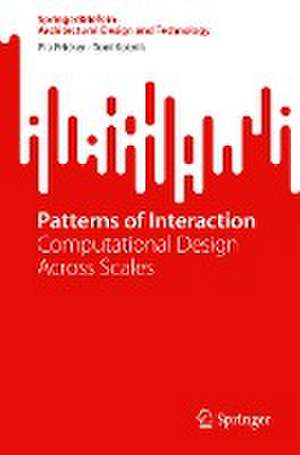Patterns of Interaction: Computational Design Across Scales: SpringerBriefs in Architectural Design and Technology
Autor Pia Fricker, Toni Kotniken Limba Engleză Paperback – 7 feb 2023
Preț: 378.12 lei
Nou
Puncte Express: 567
Preț estimativ în valută:
72.36€ • 75.09$ • 60.48£
72.36€ • 75.09$ • 60.48£
Carte disponibilă
Livrare economică 22 februarie-08 martie
Preluare comenzi: 021 569.72.76
Specificații
ISBN-13: 9789811990823
ISBN-10: 9811990824
Pagini: 87
Ilustrații: XI, 87 p. 35 illus., 12 illus. in color.
Dimensiuni: 155 x 235 mm
Greutate: 0.18 kg
Ediția:1st ed. 2023
Editura: Springer Nature Singapore
Colecția Springer
Seria SpringerBriefs in Architectural Design and Technology
Locul publicării:Singapore, Singapore
ISBN-10: 9811990824
Pagini: 87
Ilustrații: XI, 87 p. 35 illus., 12 illus. in color.
Dimensiuni: 155 x 235 mm
Greutate: 0.18 kg
Ediția:1st ed. 2023
Editura: Springer Nature Singapore
Colecția Springer
Seria SpringerBriefs in Architectural Design and Technology
Locul publicării:Singapore, Singapore
Cuprins
Convergence.- Patterns of Interaction.- Computing Land-Scapes.
Notă biografică
Pia Fricker is Professor of Computational Methodologies in Landscape Architecture and Urbanism at Aalto University, Finland. She holds a doctorate degree in Architecture and a postgraduate degree in Computer Aided Architectural Design from ETH Zurich. Her research and teaching link urban design and landscape architecture to the field of computational design culture through the lens of emerging technologies. Prior to her current position, she was Director of Postgraduate Studies in Landscape Architecture at the ETH Zurich. She is a member of the editorial board of the Journal of Digital Landscape Architecture, the Scientific Program Committee of the DLA conference, several Peer Review Committees, and expert peer reviewer for the International Journal of Architectural Computing, the Urban Planning Journal and the Journal of Architecture and Urbanism. Pia Fricker has published extensively, and her work has been exhibited, amongst others, at the Venice Biennale, the National Design Centre Singapore, the Museum of Modern Art – EMMA, as well as at the Helsinki Design Week.
Toni Kotnik is Professor of Design of Structures at Aalto University in Helsinki, Finland. He studied architecture, mathematics and computational design in Germany, Switzerland and the US and received his doctoral degree from the University of Zurich. Before joining Aalto he taught among others at the ETH in Zurich, the Architectural Association in London, the Institute for Experimental Architecture at the University of Innsbruck and the Singapore University of Technology and Design. He has been lecturing at universities worldwide as well as at museums like the Guggenheim in Bilbao or the MOMA in New York. His practice and research work has been published and exhibited internationally, including the Venice Biennale, and is centered on the integration of knowledge from science and engineering into architectural design thinking and the exploration of organizational principles and formal methods asdesign driver at the intersection of art and science.
Toni Kotnik is Professor of Design of Structures at Aalto University in Helsinki, Finland. He studied architecture, mathematics and computational design in Germany, Switzerland and the US and received his doctoral degree from the University of Zurich. Before joining Aalto he taught among others at the ETH in Zurich, the Architectural Association in London, the Institute for Experimental Architecture at the University of Innsbruck and the Singapore University of Technology and Design. He has been lecturing at universities worldwide as well as at museums like the Guggenheim in Bilbao or the MOMA in New York. His practice and research work has been published and exhibited internationally, including the Venice Biennale, and is centered on the integration of knowledge from science and engineering into architectural design thinking and the exploration of organizational principles and formal methods asdesign driver at the intersection of art and science.
Textul de pe ultima copertă
This book is a reflection on contemporary computational design thinking at the intersection of architecture, urban design, and landscape architecture, in a time marked by complex challenges like climate change, urbanization and population growth. Based on a critical rethinking of the notion of ground and the relation between the manmade and the natural environment, an understanding of architecture as regenerative practice is proposed. It aims at a built environment as landscape, at an architecture of prosthetic nature. The design approach is illustrated by a number of design experiments conducted within a studio setting and complemented by a series of conversations with leading experts on sustainable design and landscape architecture.
Caracteristici
Discusses how design approach grounded in computational design thinking overcomes limitations of a tool-based approach Presents a new form of sustainability for any specific situation and dimension than can merge on a larger continuity Illustrates the design approach by a number of design experiments, complemented by a series of conversations














